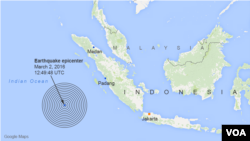A powerful and relatively shallow earthquake rocked parts of Indonesia's Sumatra island Wednesday, prompting immediate tsunami warnings, but the danger period passed without any reports of significant damage or casualties.
Reuters news agency quoted an official at the national Search and Rescue Agency in Jakarta who said "there are some who have died," but no specific details were available as night fell along the western coast of Sumatra.
Reports from Padang city and other areas shaken by the quake said panicked residents fled from their homes, but calm was restored later during the night. Padang suffered hundreds of casualties in an earthquake six years ago.
Many of the areas rocked by Wednesday's 7.8-magnitude quake were devastated by the Indian Ocean tsunami of December 2004, which claimed nearly a quarter-million lives in a dozen countries. That disaster was triggered by a much bigger earthquake, measured at magnitude 9.1, one of the strongest in modern times.
Tsunami warning
Indonesia sounded immediate tsunami warnings after the quake hit Wednesday at 6:50 p.m. local time (1250 UTC), but canceled them several hours later. Australia also canceled a tsunami watch ordered along its western coast.
Seismologists at the U.S. Geological Survey, one of the world's leading quake monitoring centers, at first reported the jolt off Sumatra's shores was magnitude 8.3, and within 10 kilometers of the surface - shallow enough to cause substantial sea-floor movements, of the type that could trigger tsunami waves.
After further study of the data, USGS lowered its estimate of the quake's strength several times, to magnitude 7.8, and also adjusted its depth to 24 kilometers.
Ring of fire
The original tsunami warning covered three Indonesian provinces - Western Sumatra, Northern Sumatra and Aceh, where about 170,000 people were killed by 2004's catastrophic quake and tsunami. Wednesday's jolt also was also felt in Malaysia and Singapore.
Indonesia's islands lie in the Pacific "ring of fire," an area of high seismic activity where tectonic plates - huge pieces of the Earth's crust - press against each other with enormous force. Earthquakes result when the plates grind past each other, and volcanos appear when the crustal movements create an opening where molten rock or magma from deep within the planet rises to the surface.






